Sumo wrestling is a sport that is deeply rooted in Japanese culture. In this article, we introduce the basic knowledge of sumo wrestling, the diet of a sumo wrestler, and other interesting facts about sumo wrestling.
Table of Contents
- What is Sumo Wrestling? Etymology and History of Japanese Sumo
- Essential Facts About Sumo Wrestling: Rankings and Positions
- Japanese Sumo Terminology
- Life of a Sumo Wrestler
What is Sumo Wrestling? Etymology and History of Japanese Sumo

Sumo, known as the national sport of Japan, has a history of over 1500 years. The exact origin of sumo is unknown, but in Japan, the search for sumo’s origins led to myths published in the Kojiki (712) and Nihon Shoki (720) about power battles overwatched by the Emperor of Japan.
In addition, sumo was performed annually as a ritual to predict the harvest for the year’s crops. It later became a court event enjoyed as a spectator sport of entertainment which continued for 300 years.
From the Kamakura period to the Warring States period, sumo training was conducted as a form of combat training for samurais. It is said that Oda Nobunaga, a great general during the Warring States period, was particularly fond of sumo.
Entering the Edo people, people who practiced sumo as a profession started appearing. By the mid-Edo period, sumo matches were held regularly which gathered many spectators. With the appearance of 3 powerhouse sumo wrestlers (力士 rikishi), even the Shogun started attending sumo events, which set the foundation for “Ozumo (大相撲)”, large-scale professional sumo wrestling competitions today.
[Facts About Sumo Wrestling #1] Sumo and Kabuki were the common people’s entertainment during the Edo period.
※ Nihon Sumo Kyokai (Japan Sumo Assoc.), “相撲の歴史”
“Sumo wrestling is a national sport in Japan,” or is it?
In Japan, sumo has not been officially declared as a national sport, but at the same time there has been no official announcement to the contrary either. Apart from sumo, other sports that are called “national sports of Japan” are judo, kendo, and kyudo.
To read about other types of martial arts in Japan, <Budo, Japanese Martial Arts: Introduction to Judo, Kendo, Aikido, Karate and Kyudo (Japanese Archery)>.
Writer's Pick
Essential Knowledge About Sumo Wrestling: Rankings and Positions
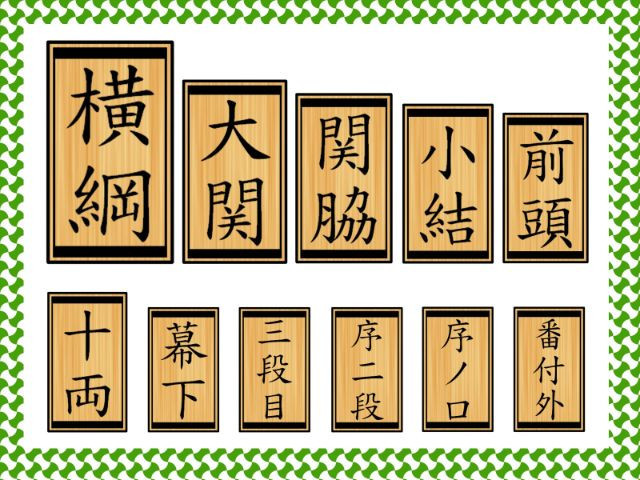
This part can be a little difficult but bear with us. Let’s learn about “banzuke (番付)” which is Japanese sumo ranks list.
番付 / banzuke / sumo rank
It is a ranking (grade) list to rate sumo wrestlers based on their skills as a sumo wrestler. Sumo ranks can be separated into 2 categories:「階級 kaikyuu」which consists of 6 ranks, and「格付け kakuduke」which consists of 10 ranks. The concept of banzuke is to climb up the ranks step-by-step through promotions which can be achieved by good results and winning matches.
Banzuke - Kaikyuu (6 ranks)
(in descending order)
-
幕内 makuuchi (highest)
-
十両 juuryou
-
幕下 makushita
-
三段目 sandanme
-
序二段 jonidan
-
序ノ口 jonokuchi (lowest)
Banzuke - Kakuduke (10 ranks)
(in descending order)
-
横綱 yokozuna (highest)
-
大関 oozeki
-
関脇 sekiwake
-
小結 komusubi
-
前頭 maegashira
-
十両 juuryou
-
幕下 makushita
-
三段目 sandanme
-
序二段 jonidan
-
序ノ口 jonokuchi (lowest)
[Facts About Sumo Wrestling #2 ~ #5]
-
The top 5 sumo ranks are known collectively as the top division of professional sumo, or「幕の内 makunouchi / 幕内 makuuchi」in Japanese.
-
Maegashira (前頭) and Juuryou (十両) ranks are further broken down with「O枚目 O maime」, or [(number) place]. For example,「3枚目」is 2nd place and「15枚目」is 15th place. 1st place however is not called「1枚目」but「前頭 hittou」, so Maegashira’s First Place is called「前頭筆頭 maegashira hittou」.
-
There must be at least 1 oozeki (大関 ) , but in the case of yokozuna, the seat may be empty.
-
The status / standing and salary of a sumo wrestler is determined by their banzuke (sumo rank).
Depending on the sumo rank, there are also differences in the way their topknot is tied, how they enter the arena, and their attire (more below).
Brief stop here >> Average Salary of Japanese Sumo Wrestler
In Japan, a sumo wrestler’s income consists of regular wages and miscellaneous income. The latter depends on tournament prize money, endorsements & sponsorships, fan contributions, and more. In the first place, the sumo wrestler’s basic wages amount depends on their sumo rank (banzuke). The higher the rank, the more they earn.
The average annual income of a sumo wrestler in Japan is as follows [as of 2021] :
|
Sumo Rank |
Annual Salary (Million Yen) |
|---|---|
|
Yokozuna |
3 ~ 36 |
|
Oozeki |
2.5 ~ 30 |
|
Sekiwaki / Komusubi |
1.8 ~ 21.6 |
|
Maegashira |
1.4 ~ 16.8 |
|
Juuryo |
1.1 ~ 13.2 |
Prize money is one of the main ways sumo wrestlers can boost their incomes. Grand prize winnings can go up to 100 million yen.
※ Bunshun, “前頭は140万円、大関は250万円、では横綱の月収は…? 力士の“収入事情”の実態に迫る” [2021.08.01] [previously on Yahoo News]
番付表 / banzuke-hyou / table of sumo ranks
A table of the sumo ranks is called「番付表 banzuke-hyou」. It contains the names of sumo wrestlers and their respective sumo ranks as well as the those in position at the Japan Sumo Association (日本相撲協会), including sumo elder (年寄り toshiyori) and referee (行司 gyouji).
New sumo rankings are published on the Monday 13 days before the first day of Hombasho (本場所), the official professional sumo tournaments. On the same day, the printed tables are also released. The table of ranking is entirely handwritten. Even the font is a unique writing style used to write the rankings only called “sumo-ji (相撲字)” which literally translates to “sumo words” or “sumo writing”. It takes 2 days to draw writing guidelines to set space for all the names, taking into account the font size and other factors, and around 10 days of intensive writing to complete the table.
The original size of the table of ranking is 109 cm long and 79 cm wide. It contains the names of more than 800 people, including approximately 650 ~ 690 sumo wrestlers and more than 200 other people, all fitting onto 1 page. The font size for sumo wrestlers’ names are based on their sumo rank, the lower their rank, the smaller the font size. After the table is completed, copies are made at half the size of the original. How many copies are made? In the case of a sumo tournament in Tokyo, around 600,000 copies. After the printed table is made, the iconic wooden board banzuke-hyou to be displayed at the Ryogoku Kokugikan (両国国技館) will be made.
[Facts About Sumo Wrestling #6] 「蒙御免 gomen koumuru」written in the largest font at the bottom of the banzuke-hyou is short for「御免を蒙る gomen wo koumuru」which means “to receive permission”. This is a tradition passed down from the Edo period when sumo wrestling was held with the permission of the Shogunate.
※ Asahi Shimbun Company, “相撲字と番付”
Japanese Sumo Terminology
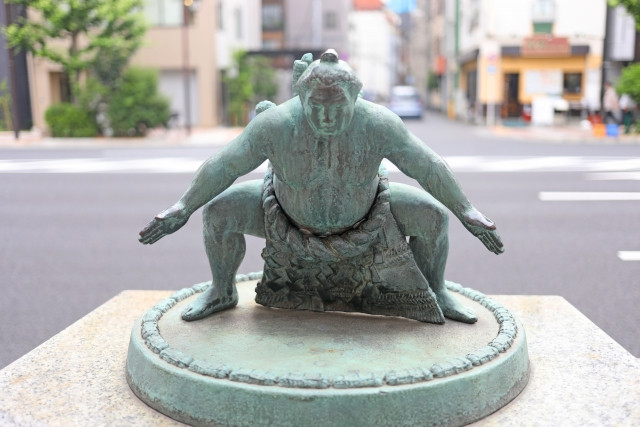
Sumo is a traditional sport and martial art with a history of over 1500 years. There are terms and expressions used only in sumo. So you aren’t totally confused whilst watching a sumo match, here are some words to know.
力士 / rikishi
「力士 rikishi」is “sumo wrestler” in Japanese. Another way to say sumo wrestler is 「相撲取り sumotori」.
相撲を取る / sumo wo toru
Meaning “to compete in sumo” or “to take part in sumo”. Note the use of the verb「取る toru」.
四股名 / shikona
A sumo wrestler’s ring name, as in the name he goes by whilst competing in a sumo match.
相撲部屋 / sumobeya
“Sumo stable” in English, is a club or organization that a sumo wrestler is affiliated with, and where he trains and lives. Except for unavoidable and exceptional circumstances, it is impossible to change your affiliated sumobeya.
土俵 / dohyou
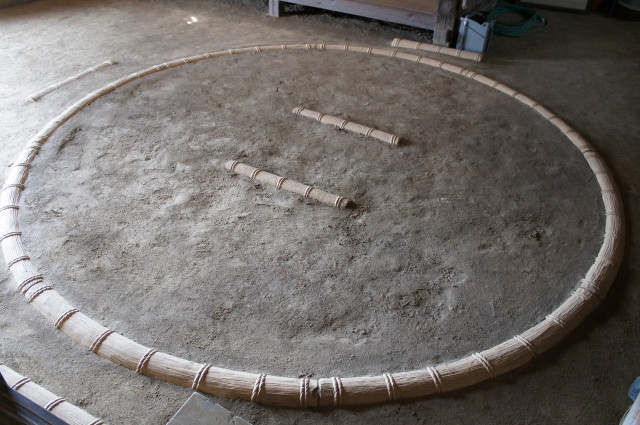
A sumo ring. The stipulated venue for sumo wrestling, and said to have appeared at the end of the 17th century. Originally it was made with 5 piles of rice sacks filled with soil lined up in a square, and the game was played inside. The circular center for sumo is called “dohyo”, and the rules of the sport is to push the opponent out of the dohyo, or to force the opponent out of the dohyo by grabbing his body and throwing him out.
The soil for building the dohyo is stacked in a square shape with each side measuring 545 cm, and the inner diameter of the dohyo is 455 cm.
大相撲 / oozumo
Professional sumo wrestling matches for spectating. Tickets are sold to those interested to watch the match. In particular, it refers to matches hosted by the Japan Sumo Association.
本場所 / honbasho
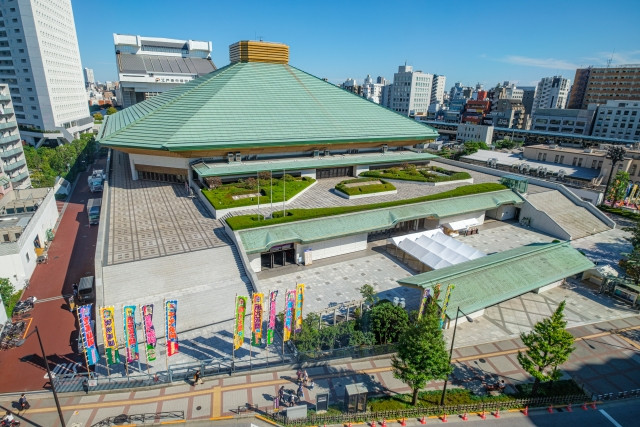
Ozumo (大相撲; professional sumo match) held regularly by the Japan Sumo Association. Based on the results of the honbasho, the sumo wrestlers’ banzuke (sumo rankings) are raised or lowered. Honbasho is held 6 times a year, with each being held for 15 consecutive days.
The first day of the Honbasho is called “shonichi (初日)”, the eighth day is called “nakabi (中日)”, and the final day is called “senshuuraku (千秋楽)”.
Honbasho Schedule in Japan
|
Month |
Official Name |
Alias |
Venue |
Start Date |
|---|---|---|---|---|
|
January |
一月場所 |
初場所 |
Ryogoku Kokugikan |
1st or 2nd Sunday |
|
March |
三月場所 |
・春場所 ・大阪場所 |
Osaka Prefectural |
2nd or 3rd Sunday |
|
May |
五月場所 |
夏場所 |
Ryogoku Kokugikan |
1st or 2nd Sunday |
|
July |
七月場所 |
名古屋場所 |
Aichi Prefectural |
1st or 2nd Sunday |
|
September |
九月場所 |
秋場所 |
Ryogoku Kokugikan |
1st or 2nd Sunday |
|
November |
十一月場所 |
九州場所 |
Fukuoka International |
1st or 2nd Sunday |
A banzuke organisation meeting is held within 3 days after a Honbasho. In cases of promotions to yokozuna or ozeki, there is a condition that the promotion must be unanimously recommended at the banzuke meeting and with approval of the board of directors. Promotions to yokozuna, ozeki or juuryo are announced the same day, but promotions or demotions of other sumo ranks are kept secret until the release of banzuke rankings before the next honbasho (check 番付表 / banzuke-hyou / table of sumo ranks).
取組 / torikumi
Meaning “individual match” in reference to sumo.
In the case of Honbasho, matches are held sequentially from around 8:00 every morning starting with the lowest sumo rank. For juuryo and above ranks, a procession ceremony called「土俵入り dohyou iri」is performed.
土俵入り / dohyou iri
A ritual or ceremony when entering the dohyou. It is carried out in 2 parts; dohyo-iri for juuryo, and dohyo-iri for makunouchi (幕の内; collective term for top 5 sumo ranks) excluding Yokozuna. They are performed around 14:30 and 16:00 respectively.
How is dohyou-iri performed?
An ornamental apron called「化粧廻し keshou mawashi」is put on by the sumo wrestlers. The referee leads the entry into the venue, and the sumo wrestlers follow whilst being introduced by their names, hometown, and affiliated sumo stable according to their banzuke, starting from the lowest rank. They climb up the dohyo and walk around it forming a circle with the dohyo as an island in the center.
At first, they all stand facing outwards, but after all the rikishi are introduced, they will turn their backs on the arena. Thereafter, they will clap their hands together, raise their right hand to hold the ornamental apron, and perform a series of movements. After which, the rikishi will leave using the same entrance passageway they came from, called the “hanamichi (花道)”.
横綱土俵入り / yokozuna dohyou iri
As yokozuna, the highest ranking sumo, the yokozuna dohyou iri is performed alone after the makunouchi dohyo-iri is over and the dohyou is cleaned.
Yokozuna are the only sumo wrestlers who can wear a tsuna (綱), a thick rope woven from white hemp cloth, around their waists (横). Hence, their title yokozuna (横綱), “rope around sides”.
After getting on the dohyo, the yokozuna claps twice, moves forward to the center of the dohyo, claps twice again facing the front, then proceeds to perform shiko (四股). Shiko is ceremonial leg raising and stomping which is done in the order of right foot → right foot → left foot. The audience will shout “Yoisho! (よいしょ)” in tandem with the rhythm of the yokozuna’s shiko. After the shiko, the yokozuna returns to the position he first took when entering the dohyou, claps twice, gives a greeting, then exits.
満員御礼 / manin onrei
Translates to “all seats sold, thank you”, but means that the sumo tournament is a “great success”. The phrase is displayed when a certain number of spectators is reached, and not necessarily “sold out”.
Sumo Match Rules and Techniques
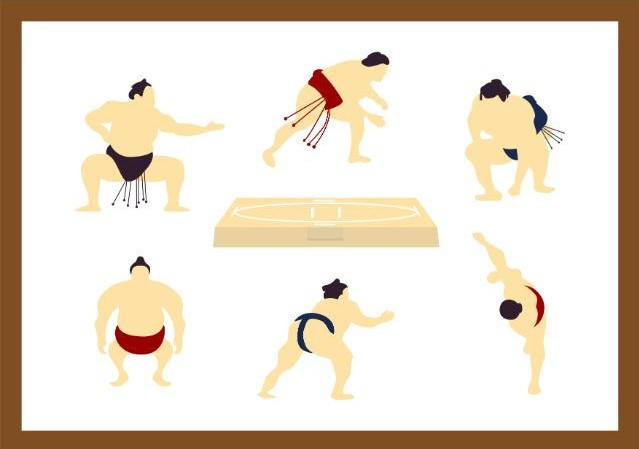
The rules of sumo wrestling are simple. You are defeated if you are pushed out of the dohyou, or if any part of your body other than the soles of your feet touches the ground. Sumo techniques are called「決まり手 kimarite」in Japanese, which means “winning techniques”. There are a total of 82 kimarite, also called「82手」.
※ Sumo Japan Association, “決まり手八十二手”
Although sumo is traditional Japanese culture, nationality has no bearing on becoming a sumo wrestler, and there is no division based on body weight like for Judo. From the point of view of those watching sumo, the rules are so simple that you can fully focus on the bout.
As the banzuke culture we introduced earlier is very strong, the moment when a lower ranked sumo, say ozeki, beats the top ranked sumo, yokozuna, is particularly thrilling! Depending on the seat, you can watch it for less than 3,000 yen. It would be more fun to watch and cheer for your favourite wrestler in person, right?
Life of a Sumo Wrestler
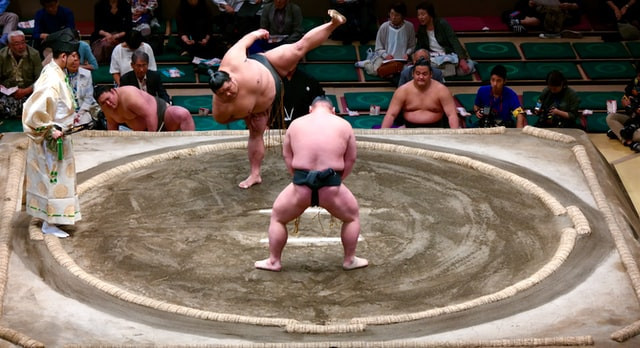
Becoming a sumo wrestler is a huge life decision that needs to be made no later than adolescence. Thereafter, the budding sumo wrestler will be enrolled in a sumo stable for training which is quite challenging. Discipline, hard work and strong self-control are absolute necessities. The stable master who acts as a coach or trainer will control most of the student’s life including diet, schedule, and clothing.
Greatest Sumo Wrestlers of All Time
With such a long history of sumo wrestling, there are of course certain fighters who stand a cut above the rest breaking records and reaching great heights. Here are four of Japan’s sumo legends:
Hakuho
Hakuho is often called the greatest sumo wrestler. As of September 2021, he has retired after a 2 decade long career due to a chronic knee injury and plans to operate a sumo stable. He holds the highest record of wins at 45 tournament wins, overwhelmingly beating the previous record of 32. His other records and titles held include most tournaments as yokozuna - 84, most career wins - 1187, and more.
※BBC, “Hakuho: Sumo wrestling's greatest champion retires”
Taiho
Taiho was considered the greatest sumo wrestler of all time up till Hakuho. One of his most memorable feats and hardest records to break is winning at least once a year consecutively from career start to retirement. He is also famed as being the youngest rikishi to earn the rank of yokozuna at 21 years old. Prior to Hakuho, he held the highest record of tournament wins at 32. He has unfortunately passed away several years ago.
※Taiho-Kikaku, "Profile"
Chiyonofuji
Chiyonofuji is a lightweight sumo wrestler as compared to his competitors being only a little over 100kg. He was not to be underestimated by his opponents however, as his skills, speed and pure muscular strength made up for what he lacked in weight. After Hakuho and Taiho, he is the record holder of tournament wins at 31. He has since passed away from cancer at 61 years of age.
※The Japan Times, "Sumo icon Chiyonofuji dies at 61"
Diet of a Sumo Wrestler

The diet of a sumo wrestler in Japan mostly consists of chanko nabe (ちゃんこ鍋), which is known as the staple food for sumo wrestlers. There is no fixed menu for what ingredients go into the hotpot but it usually contains lots of protein (seafood or meat) and vegetables.
The diet of a sumo wrestler is carefully planned to help them reach their weight target. A strict supervised diet is necessary to bulk sumo wrestlers up and for them to get enough energy for their daily training regiment.
An average male requires around 2,500 calories per day, but sumo wrestlers consume at least 4,000 calories a day. They usually consume only 2 huge meals a day skipping breakfast.

[Facts About Sumo Wrestling #7] Ryogoku (両国) City in Tokyo is known as the home of sumo. This is where the national sumo arena Ryogoku Kokugikan (両国国技館) is located. Sumobeya, chanko nabe restaurants, and sumo statues can be found here.







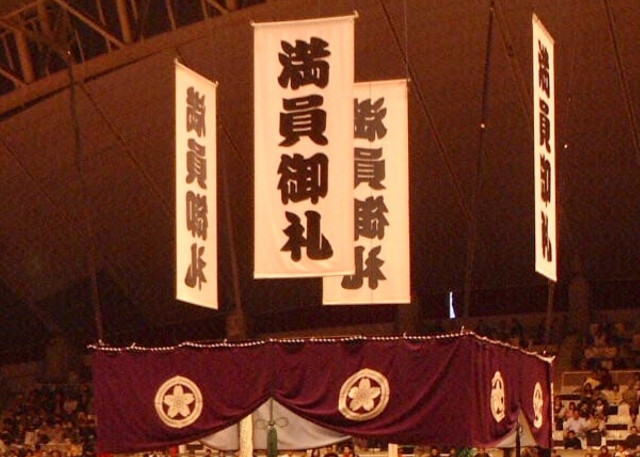

















.jpg)











